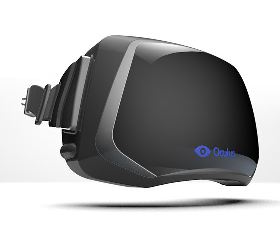It seems a new revolution in computer displays is around the corner. VR, or Virtual Reality has been around as a concept for quite a long time, and on the surface of it, it seems simple enough. Yet even today, decent VR sets cost thousands of US dollars. If Palmer Luckey has anything to do with it, that is all about to change.
Palmer’s Occulus Rift is a VR headset that aims to be cheap and thus accessible to the average consumer. He believes he has the basic design for the device ready, and has launched a Kickstarter in order to get the prototype in the hands of as many developers as possible. He intends for this prototype to be purchased by developers so that they can work on integrating support for it in their next project.
The Occulus Rift developer kit currently available for a minimum of $300 via Kickstarter, and will come with an SDK that can be used by developers to add support for Occulus in their game. As for the Occulus Rift hardware itself, here are the specifications for that:
Head tracking: 6 degrees of freedom (DOF) ultra low latency
Field of view: 110 degrees diagonal / 90 degrees horizontal
Resolution: 1280×800 (640×800 per eye)
Inputs: DVI/HDMI and USB
Platforms: PC and mobile
Weight: ~0.22 kilograms
It is important to note—and the Kickstarter page makes this patently clear—that this is a developer kit and not a consumer product. For one it is of lower quality. The consumer version of the product will be released later in the future, and that version will be for actual gaming or other purposes. Right now there are no games that even support this technology, and that in fact is why there is this Kickstarter.
What is most important about this project—and this is something that makes it different from the average garage project by some random person—is the amount of support and backing this has received from industry veterans such as John Carmack of id Software, Gave Newell and Michael Abarash of Valve, Cliff Bleszinski of Epic Games, and David Helgason of Unity. Here is what they have to say and it is all positive:
- “What I’ve got now, is, I honestly think the best VR demo probably the world has ever seen.” — John Carmack, id Software
- “Needless to say, I’m a believer… We’re extremely excited here at Epic Games to get the Unreal Engine integrated with Oculus.” — Cliff Bleszinski, Design Director Epic Games
- “I think this will be the coolest way to experience games in the future. Simply that… that big.” — David Helgason, CEO Unity
- “I’m really looking forward to getting a chance to program with it and see what we can do.” — Michael Abrash, Valve
- “It looks incredibly exciting, if anybody’s going to tackle this set of hard problems, we think that Palmer’s going to do it. So we’d strongly encourage you to support this Kickstarter.” — Gabe Newell, President and Owner Valve
These aren’t some made up quotes for pulling people in either, these people appear in the Kickstarter video to say as much. Additionally, John Carmack has publically demonstrated a version of his game Doom 3 running on this headset at the recent QuakeCon and E3. The Unity Engine, and the Unreal engine (by Epic Games) will both add support for this technology as well.
The reason these people are excited, and you should be too, is that VR is a hard problem to solve, and this might just be the biggest step towards making it possible; that first product that introduces a new technology that soon becomes a staple accessory.
Before we go ahead, we should also look at a related concept, AR or Augmented Reality, and how it differs from VR. AR involves mixing virtual information on top of the real world such that it is hard to notice where one starts and the other begins. Imagine this, if you don’t like a particular advertisement, your AR headset to detect whenever that advertisement is in your field of view, and replace it with a picture of, say, sleeping puppies, everyone likes that. AR is about having virtual content interact with real content, while VR is about entirely replacing your world with a virtual one. Such as that of a game.
On the surface VR might seem like a simple concept, just stick a display on a headset and voila! However VR isn’t just about display, but about immersion, and it takes more than just a display to make a person feel immersed in the environment. An important component is recording the person’s orientation, so that the display on screen can respond likewise. Did the person move his head to the left? The display should change such that the person feels that they have really moved in the world. Did they tilt or rotate the head? The display should change.
There are a number of challenges that prevent the experience from a VR headset from being immersive. First of all is the lag. As a person moves their head, the display should imminently render the appropriate content. If there is too much lag it will not feel immersive.
This turns out to be quite challenging when you look at what all needs to happen when you move your head slightly. Firstly the sensors on the device detecting the movement of your head send the signal to your computer. The game engine uses this data to update your coordinates in the game world and render the new scene, this is then sent back from your computer to the display. All this has to happen fast enough that the user doesn’t notice it even took time. According to John Carmack that means it should happen in under 20 milliseconds if possible.
Remember that at this time scale, even otherwise irrelevant things such as how much time does the LCD control circuitry need to process the image data, or how much time the LCD panel takes to display an image sent to it, all become relevant. If you increase the resolution, this lag will increase, but if you decrease the resolution too much it will simply look bad. Till now the technology just did not exist to do this fast enough, and at high enough quality, and if it did, it cost too much. Remember, it also can’t be too heavy, you have to wear it on your head.
There is also an issue of optics, with LCD panels placed so close to the eyes that they cannot naturally focus on it. You need some complex optics to help them focus on these displays. These optics add distortions that need further optics to correct for the distortion.
So how did one guy succeed where major companies failed? It seems that the major companies were focussed on the applications on this technology in military, and were working on a check-list-based approach i.e. the display has to have this resolution, and this FPS with so and so features. They did not think of compromising on these primary factors and considering the end experience instead from an immersion standpoint. As you will see the resolution of this display is actually quite bad by today’s standards, just 640×800 per eye. However when you move you head and the world moves around you, it becomes less of an issue.
We mentioned before that optical distortions are another issue in head-mounted displays. Well, the Occulus Rift bypasses some of this by building the distortion compensation in the software instead of hardware. Of course this adds some time to processing, but it is minuscule enough thanks to shaders. This reduces the cost, and is the kind of compensation that had not been made till now.
You can find out in more detail by watching this panel called Virtual Insanity involving Michael Abrash (who is working on augmented reality stuff at Valve), John Carmack, and Palmer Luckey (the one who created the Occulus Rift) discuss virtual reality and its challenges. It’s around an hour in length, but worth it if you are interested in virtual reality and technical stuff.
While the current push for VR is certainly in the field of gaming, it is important to note that that isn’t all it is useful for. This already gives a wider field of view that you would get otherwise, which makes it a good way to consume other kinds of media, such as videos. Most importantly it could kick off a whole new set of futuristic interfaces for computers.
A device such as this could do away with the need for a multi-monitor setup. Instead of using multiple monitors, or even a single monitor you could use a VR headset and the content it displays could change based on where you look. With a headset you get a monitor of arbitrary size and scale. It would require new interfaces and new approaches to window management, but it stands to give a definite boost in productivity.
While 3D might be mostly a gimmicky technology that rarely increases immersion, this stands to deliver the real deal. Hopefully eventually it will move beyond just gaming and embrace new forms of software that can only be imagined in context of a new age of hardware.



